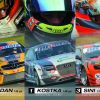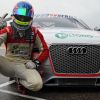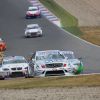Feature: Tyres in touring car racing
In this special feature, Pietro Casillo looks into the importance of tyre development in touring car racing and how it links to the development of tyres for the manufacturers’ road cars, with touring cars latest tyre competitor, Hankook.
One of the most important parts of a car is the tyre. On our road cars we tend to take them for granted, but in motor racing the use of the tyres can make the difference between victory and a retirement, as we have seen many times before, especially in the World and British Touring Car Championships.
Over the last few years Yokohama, Hankook and Dunlop have been the most engaged to the various touring car series around Europe. TouringCarTimes has spoken to Manfred Sandbichler, Hankook’s Motorsport Europe director, and Hankook’s engineer Thomas Baltes, to discuss the issues behind racing tyres.
What has emerged from this inquiry has been quite surprising, also because a lot of the racing technology goes into the tyres we use every day on our road cars.
“The design and engineering side of the tyres takes quite a long time,” explained Baltes. “For instance, with the DTM, it took three to four months, including testing and data analysis. Once the tyre has been approved for use by the series’, in the DTM’s case ITR, then the main production can start. Once we get the green light, it doesn’t take too long to go from scratch to get the tyre ready to race; it’s a mainstream production. In a few hours a tyre is ready to be fitted on a car.”
All the racing tyres developed by Hankook share a common base, which is regulated by the DTM:
“The tyres share a common series of studies. The DTM tyres, for instance, cannot even be bought and are not fitted on anything other than the DTM cars. Of course, for the Superstars, we used the technology and the work done for the DTM tyres to develop them for the different series. Then, of course, we have a customer programme, and they can choose between different measures, constructions and compounds.”
“The main development was for the DTM,” echoed Sandbichler. “That is, let’s say, the basic tyre for all the different series we support, including the Superstars Series and the TTA Elitserien, as well as the GT Sprint and many other series around Europe.”
From the outside it may look easy to build a tyre, especially when only one manufacturer is used, but that is not the case, as Baltes explains:
“In the pre-season of the DTM we created a completely new tyre, because with the new rules the tyre size is different and so are the cars. The difficult thing is to give all the three manufacturers the same tyre, although the cars are very different to other. That is even more true in Superstars, where there are many different cars and manufacturers, and of course the technical properties of the tyre must not favour anyone. It’s not easy but we reached the goal.”
It is very interesting to know that a lot of what is learned in motorsport is used on our road cars as well.
“Motorsport is extremely important for us,” said Sandbichler. “All the things we learn, not only on race tracks but also in rallies, give our engineers a better understanding of how our tyres work in extreme situations. In racing, you have to face extreme heat and extremely cold temperatures as well, and wet tracks of course. It’s a great school for our engineers to collect data and then transfer what we learned into the normal tyre production.”
Baltes explained that some of the Hankook road tyres are ‘close relatives’ of the ones used in the DTM.
“There’s a lot of our racing technology in our road tyres, just like for every tyre manufacturer in motorsports. To give you an example, I could say that our high performance tyres are barely one step below our racing products, and especially, but not only, on those ones, what we learn in racing is transferred to the road tyres.”
The engineer went on to describe the procedures used to ensure the racing tyres are not only high-performance products, but also safe to use.
“For us safety is the main area to focus on, because we’re talking about human beings driving the cars. Then of course we focus on the performance, so that the drivers get a clear feeling of what the car is like and how it behaves.”
“In our testing sessions we don’t only look for short runs, we also go for longer runs to see how the tyre behaves and ask the driver about how the tyre feels. It must be okay even after the longest runs. After having checked the tyre and having seen that everything is working properly, then we can approve the tyre and compound to be produced for a racing series.”
Sandbichler went on to explain how a tyre manufacturer works out its motorsport strategy.
“We started this programme as a long-term strategy many years ago, for the Nurburgring 24 hours, and to develop the right tyres for the different challenges and series. Two years ago we entered the DTM and from then on we kept improving.”
Hankook is not only the sole tyre manufacturer in many series around Europe, but has to focus on its customers as well.
“It may look like we’re only interested in big cars, like Superstars and DTM, but in the VLN and the 24 hours of Nurburgring, for example, we have several customers running tyres from 15 inches on, and that’s a wide base of customer racing for us. Of course there is more interest from the public in all the bigger cars, but we don’t forget that racing can be done with any car and we provide the best possible material to our customers as well. ”
Although the Korean manufacturer is the exclusive tyre supplier for many major series around Europe, including DTM, Superstars and the TTA (now the STCC), there are more areas which are interesting for the future, according to Sandbichler.
“Europe is the mother of motorsports, so of course it’s very interesting for any manufacturer interested in the sport, but there are many countries that are “waking up”. Of course in Asia you have Japan and China, which are growing fast, and America is another big and interesting market so all those places are interesting for us. India and Russia are also growing and motorsport is getting more and more popular in those countries. Of course, though, Europe is the place where everybody wants to be at first.”
As 2012 Superstars International Series runner-up and former Formula One driver Vitantonio Liuzzi explained to TouringCarTimes, the tyres are the main focus point when talking about the setup of a car.
“The tyres are very, very important, because they are the only point of contact between the car and the tarmac, so it’s vital to get them working in the best way. I come from the Formula One world, where we took care of all the details of the tyres, from the pressures on to the quality of the rubber. In the Superstars we have very good tyres and, most of all, very consistent. We never encountered a situation in which a set of tyres was behaving differently, whereas in many other series, including Formula One, it has happened. In the past season we had difficult situations, like in Hungary or in Vallelunga, and we were able to come out of them without any problems.”
As the insiders can tell, designing and manufacturing a tyre is not as easy as it may look from the outside. Months of studies and years of experience are crucial to make a tyre an ultimate winner, both on track and on our ordinary streets. As Hankook has told us, what we see in motor racing leads to better road tyres, in terms of both safety and performance.










